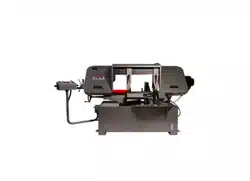Loading ...
Loading ...
Loading ...

9
6. Remove blade from both wheels and out of
each blade guide.
7. Make sure teeth of new blade are pointing in
proper direction of travel. Work blade all the
way up into blade guide bearings (E) and guide
blocks (F) with back of blade against back-up
bearing (G), as shown in Figure 8-2.
Figure 8-2: blade guides
NOTE: If roller bearings need adjustment refer
to sect. 8.5.
8. Position blade through upper slot. Put light
tension on blade and work it onto both wheels.
Make sure back of blade is against shoulder
of both wheels.
9. When you are sure that back of blade is against
shoulder of both wheels and properly inserted
into guides, finish putting tension on blade.
10. Connect power and jog blade on/off button to
be sure blade is in place and tracking properly.
If blade is not tracking properly refer to sect. 8.3.
8.2 Blade tension
Blade tension has been preset by the manufacturer;
if further adjustment is required, or after installing a
new blade, turn handwheel (D, Figure 8-1)
clockwise to appropriate tension for the installed
blade.
8.3 Blade tracking
Blade tracking requires saw to
be operating. Use extreme caution and keep
hands away from moving blade areas.
Blade tracking has been initially set by the
manufacturer. Adjustment is rarely required when
blade is correctly welded and used properly. For
proper blade tracking, the back of blade should be
located against blade wheel shoulder. If it is not,
proceed as follows.
NOTE: Do not hurry tracking adjustments. Patience
and accuracy here will pay off with more accurate
cutting and much longer machine and blade life.
1. Raise bow enough to allow motor to operate.
2. Loosen four knobs and open wheel cover (A,
Figure 8-1). Remove upper gap cover (B,
Figure 8-1), lower blade guard (C, Figure 8-1),
and guide brackets (J, Figure 8-1).
3. NOTE: Maintain proper tension at all times
using blade tensioning mechanism.
4. Loosen center locking screws (H
1
, Figure 8-3)
in all three hex adjustment screws (H
2
).
Figure 8-3
While performing the
following, keep blade from rubbing
excessively on wheel shoulder, which can
damage wheel and/or blade.
5. Start saw blade, and slowly turn single hex
adjustment screw (H
3
, Figure 8-13) to tilt idler
wheel. Turn screw outward so that blade starts
to move away from wheel shoulder; then
immediately turn screw inward so that blade
stops, then moves slowly back toward shoulder.
6. Turn off saw blade.
7. Hold hex adjustment screws (H
2
) with a wrench
and tighten center locking screws (H
1
). Make
sure hex adjustment screws do not move while
tightening the center screws.
8. Install the two guide brackets. Position guides
so that bearings just touch the blade. Refer to
sect. 8.5.
9. Install upper gap cover (B, Figure 8-1) and left
blade guard (C, Figure 8-1).
10. Close blade wheel cover (A, Figure 8-1) and
secure with the four knobs.
8.4 Blade guide bracket adjustment
The brackets (J, Figure 8-1) should be set as close
to vise jaw as possible. The right bracket has
minimal adjustment and is set by the manufacturer
to clear the stationary vise jaw. The left bracket can
be moved to accommodate position of floating vise
jaw. Loosen handle and slide bracket into position,
then retighten handle.
Loading ...
Loading ...
Loading ...
